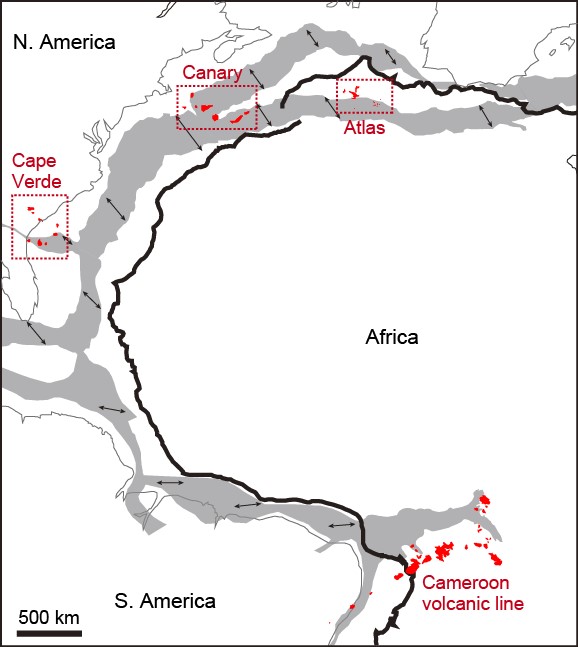Origin of ocean island basalts in the West African passive margin without mantle plume involvement
Rationale
The generally accepted whole-mantle convection theory is supported by geochemical data on OIBs, which indicates that the source mantle contains various types of recycled materials that were transported through subduction or delamination processes. Time-progressive linear hotspot tracks aligned with plate motion and large igneous provinces where voluminous magmatism occurred within a few million years have been considered as evidence for the deep mantle plume hypothesis. On the other hand, geodynamical studies have proposed both plume and non-plume hypotheses for the initiation of OIB magmatism.
The OIB suites and their closely related continental volcanic regions, which are located western offshore and inland of the West Africa (the Madeira Islands, the Canary Islands, the Cape Verde Islands, Cameroon volcanic line [CVL], and Atlas mountains), denoted as West African passive margin intraplate basalts (WAPM-IB) in this study, generally comprise linear volcanic chains. Variations in elemental and isotopic compositions of basaltic rocks from WAPM-IB have been generally explained by the involvement of plume components, involving recycled crustal/lithosphere materials. However, the lack of a clear age progression within volcanic chains for the WAPM-IB is inconsistent with the formation of hotspot tracks by melting of stationary plumes. Thus it is important to evaluate whether the geochemical variations of magmas in the WAPM-IB can be explained without a plume component and instead by the non-plume hypothesis.
Methods
Here we report on major and trace element concentrations and high-precision Sr, Nd, Hf, and Pb isotopic data for 90 basaltic samples from five CVL volcanoes from oceanic and OCB regions: Annobòn, São Tomé, Principe, Bioko, and Etínde. We also make use of the high-precision isotopic data from Mt. Cameroon lavas previously analysed in our laboratory (N = 26). Then we examine the geochemical variation of the oceanic and OCB CVL to determine whether it can be explained solely by the lithospheric and asthenospheric mantle components that are present beneath the CVL without considering any Cenozoic plume materials. Finally, the non-plume hypothesis for the origin of WAPM-IB is discussed in the context of the geochemical variation of WAPM-IB.
Results & Discussions
The isotope systematics of the CVL samples studied here can be explained by a mixture of the three refertilized SCLM components (Group 1 kimberlite-source mantle, Mesozoic E-DMM-derived melt, and pyroxenite) and the DMM. Thus no external Cenozoic plume component was necessary for the genesis of CVL magmas.
The major sources of the Canary Islands, Atlas Mountains, continental CVL, and most of the Cape Verde Islands could be the same four identified components as those of the CVL data studied. Exceptionally, the data from the Madeira Islands show distinct compositions from the range of the CVL.

Our results infer that the geochemical characteristics of WAPM-IBs is strongly related to the location of the rift axis during the Mesozoic continental breakup and the distribution of the SCLM beneath the Atlantic Ocean. We constructed a map of the African–South American continents and the rift axis during the Jurassic to Cretaceous periods, using data from previous studies (Fig. 1). The map shows that the current position of the Canary Islands, southern area of the Atlas Mountains, southern Cape Verde islands, and the CVL in relation to the coast line of the African continent were located on or near the Mesozoic rift axis. The location of the Mesozoic rift axis in the Atlantic Ocean should roughly mirror the current position of continent–oceanic boundary. Beneath such a past rift zone, it is likely that the edge of cratonic SCLM, thinned lithospheric mantle, or underplated lower SCLM present.
The generation of refertilized SCLM-derived magmas can be triggered by low-amplitude thermal or compositional anomalies of the sub-lithospheric asthenospheric mantle (Fig. 2). Sub-lithospheric small-scale convection (SSC) is the most likely dynamical process of the upper mantle that can initiate melting processes. SSC causes asthenosphere of a normal temperature to rise in places of thin lithosphere and sink in zones of thick lithosphere such as beneath the CVL. The upwelled SSC erodes the lithospheric mantle, which is replaced by asthenospheric mantle.

Conclusions
We conclude that, from a geochemical, geophysical, and geodynamical point of view, genesis of WAPM-IB is strongly controlled by the former location of the Mesozoic rift axis, and a plume rising from the lower mantle is not necessary for the generation of the magmas in these regions.
References:
- Iyasu Getachew Belay, Ryoji Tanaka, Hiroshi Kitagawa, Katsura Kobayashi, Eizo Nakamura. Origin of ocean island basalts in the West African passive margin without mantle plume involvement, Nature Communications, 10, 3022 (2019). doi:10.1038/s41467-019-10832-7, dream/20190607100630-468419.